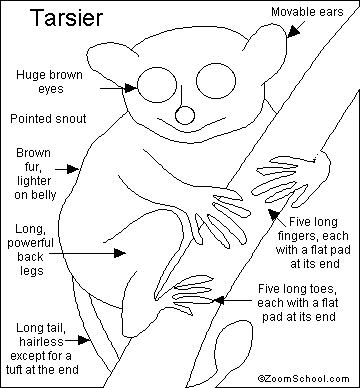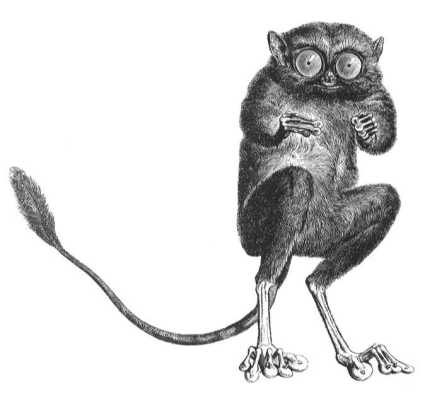|

Common Names: Tarsier
Discoverer: Heude, 1888
Category: HIGHLY VULNERABLE
Desciption: Tarsiers are small, weighing only 113 - 142 grams (4 -5 ounces). Tarsiers are named for their special elongated tarsal bones, which form their ankles and enable them to leap 3 meters (almost 10 feet) from tree to tree. They have a long, partly hairless tail that arcs over their back when they hop on the ground. The eyes are the tarsiers most notable features. Each eye is bigger than the entire brain. tarsiers can rotate their head almost 180 degrees in each direction, like owls. All tarsiers hunt at night, exclusively for animal prey. Their diet includes primarily insects such as cockroaches and crickets and sometimes reptiles, birds, and bats. One tarsier species is found in the Philippines.Four species are currently recognized in Indonesia and another (Tarsius sangirensis) has been proposed, based on recently gathered field data on vocalizations, measurements, and genetics. Philippine tarsiers have gray fur and a nearly naked tail. The middle finger is elongated. Habitat: Secondary lowland and coastal forest of Bohol.
Behavior Nocturnal and Arboreal.Philippine tarsiers use hollows close to the ground for hiding. In captivity, individuals may huddle together or intertwine their tails. No male parental care has been observed. These tarsiers have intestinal parasites and external parasites such as Trichomonas. Scent marking: Males have epigastric gland used for scent marking.Vocalizations: The loud call is a loud piercing single note. The contented call is a soft sweet bird-like trill. Several individuals make a chirping locust-like communication." Females have a vocalization that signals their approaching sexual receptivity.
Interesting Information : Tarsiers share some characteristics of both the prosimians and the anthropoids, while maintaining characteristics unique to themselves. Taxonomists have classified them as intermediate between both groups and have assigned them to their own infraorder, which has just one living genus - Tarsius. Their relatives in the fossil record are found going back to the Eocene epoch, from 54 to 36 million years ago. Like many prosimians, they are nocturnal and have grooming claws and bicornuate uterus. Like anthropoids, they do not have a tapetum (a reflective layer in their eyes), and their eye sockets have postorbital closure rather than the postorbital bar of the prosimians. In tarsiers, the internal structures of the nose and ears and the blood supply to the brain and to a developing fetus are more like those of monkeys than of lorises. The monthly sexual swellings of female tarsiers are also similar to those in anthropoids. Unique among primates, tarsiers have only 2, rather than 4, incisors in their lower jaw. Their dental formula is 2.1.3.3 1.1.3.3 x 2 = 34. : Tarsiers share some characteristics of both the prosimians and the anthropoids, while maintaining characteristics unique to themselves. Taxonomists have classified them as intermediate between both groups and have assigned them to their own infraorder, which has just one living genus - Tarsius. Their relatives in the fossil record are found going back to the Eocene epoch, from 54 to 36 million years ago. Like many prosimians, they are nocturnal and have grooming claws and bicornuate uterus. Like anthropoids, they do not have a tapetum (a reflective layer in their eyes), and their eye sockets have postorbital closure rather than the postorbital bar of the prosimians. In tarsiers, the internal structures of the nose and ears and the blood supply to the brain and to a developing fetus are more like those of monkeys than of lorises. The monthly sexual swellings of female tarsiers are also similar to those in anthropoids. Unique among primates, tarsiers have only 2, rather than 4, incisors in their lower jaw. Their dental formula is 2.1.3.3 1.1.3.3 x 2 = 34.
Threats: Habitat destruction and/or hunting
|
